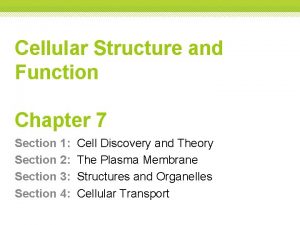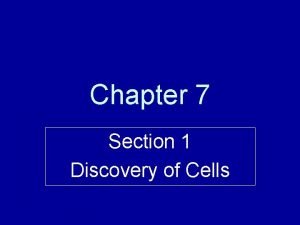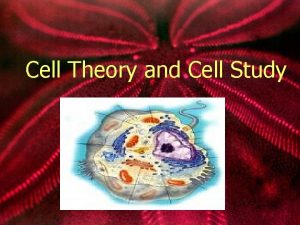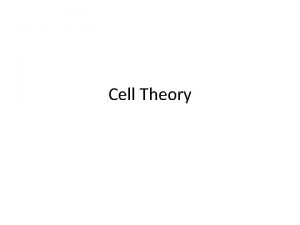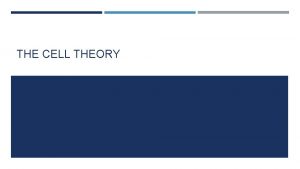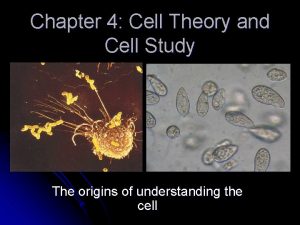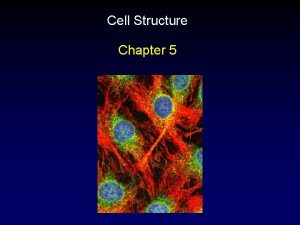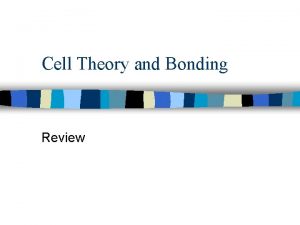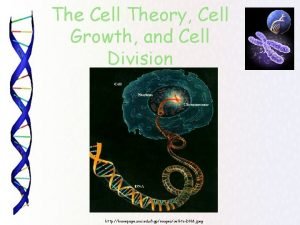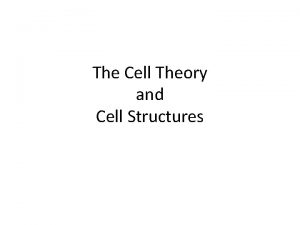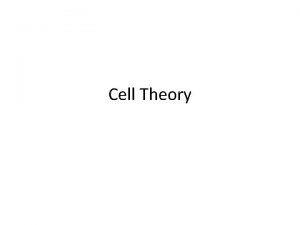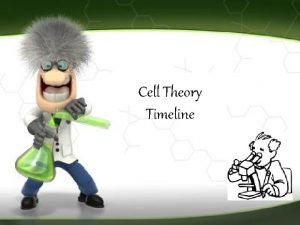Chapter 4 Cell Theory and Cell Study The














- Slides: 14

Chapter 4: Cell Theory and Cell Study The origins of understanding the cell

A. The Cell Theory a. All organisms are ________________. Organisms can be either ______, or _________ b. The cell is the _________________ of organisms. _________ happens within a cell all cells carry on similar _____________ c. Cells come from ______________. Belief that life started as __________ Cells ______ over millions of years to become all the different forms of _______.

B. Exceptions to the cell theory 1. _________ Scientists debate whether to consider them ______ Viruses are _____ made of ______ but they can ______ and carry out _______ inside a host cell 2. Where did the 1 st cells come from? Theory of ________________________ – 1953 Prove Spontaneous Generation Simulated _______ to find that _____________ could be spontaneously formed from ______________


C. History of the Cell Theory - Discovery of the ________ allows scientists to first view cells. Before the discovery of cells people believe diseases caused by __________. Cell Size and Scale

1. __________ English scientist in 1665 looked at ____ under the microscope what he saw he called ______ he really saw the __________.

2. _____________ Dutch Scientist in 1674 discovered _________ in pond water also looked at ______, sperm, and other human cells but did nothing with it through high power simple microscopes.

3. ________ English scientist in 1833 discovers and names the _______

4. __________ German scientist in 1838 “all _______ were composed of cells. ” 5. __________ German scientist in 1839 “all _______ were composed of cells. ” Schleiden and Schwann are credited with publishing the _______

6. _________ French scientist 1824 – 1830 “the cell is the ___________________” discovers the process of _____ 7. ___________ German scientist in 1858 “cells come from ________”

D. Equipment 1. Parts of the Compound Light Microscope a. ______ b. __________ c. ________ d. _________ e. _________ f. Mirror / Illuminator, Body, Stage, Base 2. ________________________________ 3. ________ Resolution is the ability to _______ between 2 different items

4. Measuring with the Microscope a. _____ measure a cell with a _____ – not accurate b. Use units called _____ (um) 1 mm = 1000 um 1 mm How big is this one cell? How many cells fit across? Measure field of view Field of view = 1. 1 mm 1. 1 mm = 1100 um Roughly – 10 You have to estimate the best you can 1100 um Divide the distance by your estimation of cells 1100 um / 10 cells = 110 um / cell

5. Other Types of Microscopes a. ______ - 1 lens = magnifying lens b. _______ - use both eyes, 3 D image, used for micro-dissections c. ___________ – extremely high magnification (100, 000 x) and resolution

6. ________ Centrifuges separate materials based on density by spinning very rapidly 7. _________ Tissue culture is the growth of cells in the lab
 Chapter 4 cell theory and cell study
Chapter 4 cell theory and cell study Chapter 7 section 1 cell discovery and theory
Chapter 7 section 1 cell discovery and theory Chapter 7 section 1 cell discovery and theory
Chapter 7 section 1 cell discovery and theory Chapter 27 quantum theory answers
Chapter 27 quantum theory answers Hình ảnh bộ gõ cơ thể búng tay
Hình ảnh bộ gõ cơ thể búng tay Frameset trong html5
Frameset trong html5 Bổ thể
Bổ thể Tỉ lệ cơ thể trẻ em
Tỉ lệ cơ thể trẻ em Gấu đi như thế nào
Gấu đi như thế nào Tư thế worms-breton
Tư thế worms-breton Chúa yêu trần thế
Chúa yêu trần thế Các môn thể thao bắt đầu bằng tiếng đua
Các môn thể thao bắt đầu bằng tiếng đua Thế nào là hệ số cao nhất
Thế nào là hệ số cao nhất Các châu lục và đại dương trên thế giới
Các châu lục và đại dương trên thế giới Công thức tính thế năng
Công thức tính thế năng

